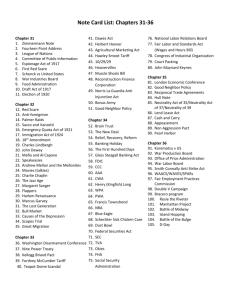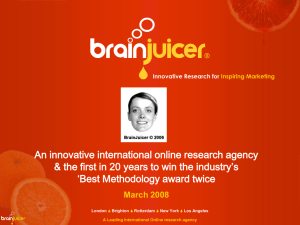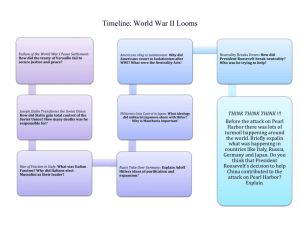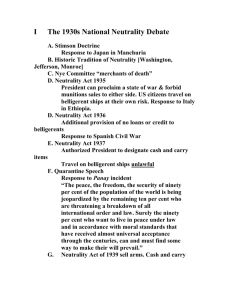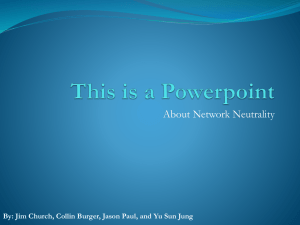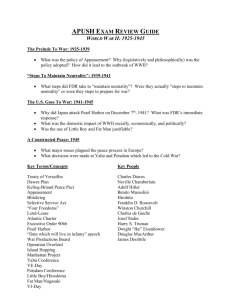Generating better insights & ideas
advertisement
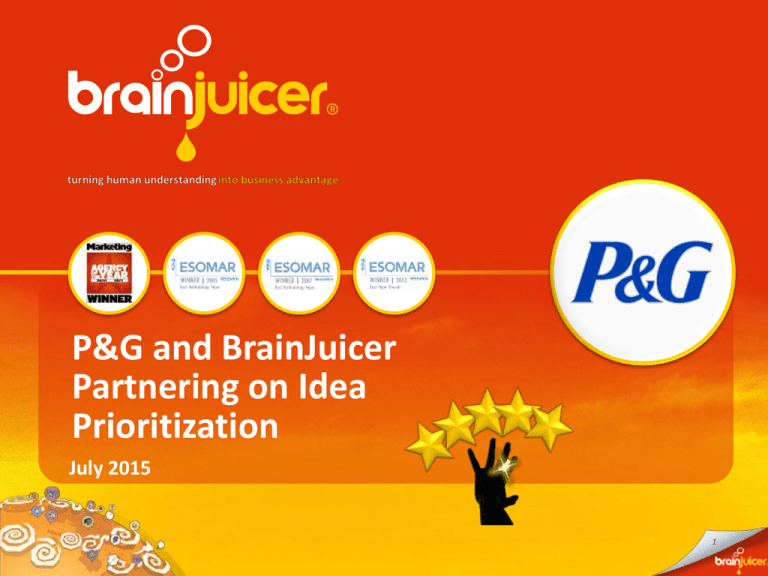
P&G and BrainJuicer Partnering on Idea Prioritization July 2015 1 Contents Background P&G Experience & Performance To Date Principles & Watch Outs Other Considerations & BrainJuicer Tips Additional P&G Meta Findings About Predictive Markets 2 Background P&G and BrainJuicer have been partnering on idea testing using BrainJuicer’s Predictive Markets methodology since 2007. Predictive Markets uses the wisdom of the crowd and projective design rather than personal intention. BrainJuicer’s framework ultimately rates each idea on a simple, intuitive 1- to 5-star rating scale, indicative of business potential. The purpose of this deck is to highlight what we’ve learned to date and provide perspective on how P&G can create winning, 5-star ideas. 3 P&G Experience & Performance To Date 4 P&G Cases to Date (July 2015) Since 2007… studies markets Brazil China France Germany Greece Hungary Italy Japan Mexico Russia US UK ideas tested 41% in Beauty 11% in Health 10% in Fabric Care 10% in Family Care 8% Home Care 6% in Grooming 6% Overall Brand 4% in Food 2% in Feminine Care 2% in Baby 82% New Product Development 18% Non-NPD 35% Communication or Claims 32% Names 11% Positioning Statements 9% Promotion Ideas 7% Other 6% Early Pack Design Iterations 2013 Global FEI Pilot in Hair Care for IQR 5 5 Predicting Market Impact Distribution of P&G Ideas vs. BrainJuicer Database Next Big Thing 10% Market Beater 14% Solid Investment 3% Top 5% Next 10% Next 10% 28% Low Returns 45% High Loss Risk Next 25% US Predictive Markets Norm Bottom half 6 The 5 Star Guide to Likely Business Potential Reference Guide Next Big Thing Market Beater Solid Investment Rare, top 5% of the database ideas typified by very strong trading & emotional engagement and likely to deliver strong in-market success. Progress without delay. Very strong versus the database (top 5-15%) and likely to deliver in-market success. Progress. Clearly above average (top 15-25% of the database) and in most cases recommended for progression. Low Returns Still above average, but unlikely to make much impact in market. In some cases ‘progress with improvements’ – that is, positive energy ideas or strong polarizers. US Predictive High Loss Risk Below average idea, do not progress unless positive energy idea or strong polarizers, with obvious fixes Markets Norm 7 Emotional Profile of P&G Ideas By Star Rating 5 and 4 star ideas are characterized by significant positive emotion. Neutrality is a hurdle. 2.15 1.91 2 1 3 1 1 1 12 1.75 4 1 0 1.58 6 2 1 1 1.39 1.70 12 9 Contempt Disgust 5 1 2 2 21 27 Intensity Score on scale 0 to +3 5 1 1 2 Anger Fear 33 29 Sadness Neutral 39 Happiness 67 55 Surprise 48 40 36 27 18 19 5-Star 4-Star 18 17 3-Star 2-Star 13 1-Star 17 Global Norm 8 Neutrality – The Key Hurdle To Overcome Neutrality is the main hurdle for P&G’s 2-star ideas. Getting the crowd’s attention with compelling news delivered in an easy-tounderstand, intuitive, System 1 way is key to conquering emotional neutrality and bolstering excitement and positive emotions. Let’s take a look at best practices for the future to reduce neutrality and create 5-star winning ideas! 9 The Path to 5-Star Success Principles & Watch Outs for creating and designing new ideas 10 5-Star Principles 1 Show Don’t Tell We now know that human decisions are largely driven by System 1 - the fast, emotive and instinctive part of the brain. We think much less than we think we think, which means the traditional persuasion approach is flawed. Though we do not yet have any parallel cases with P&G, other evidence suggests System-1 ideas have a better chance of success than traditional concepts. The goal is to immediately “click” with consumers. 2 Be NEW news! Neutrality for P&G ideas is often linked to the perception that many similar products already exist. The idea should immediately feel new and different. The goal is to surprise people! “There are many kinds of wipes in the market, this is nothing new.” 1. 2. 3. 4. Seek to SECUCE rather than persuade Use metaphorical images to help it ‘click’ Explain without RTBs Think ADCEPT! It shouldn’t take more than a few seconds to describe what makes an idea special. Seek to convey it simply and intuitively. 11 5-Star Principles 3 Make life EASIER! We want things to be easy. We yearn for the easiest route. It’s why the most successful innovations are always perceived to make life easier than today’s best option. P&G’s 5- and 4-star ideas intuitively convey ease and value, such as 2-in-1 combo benefits or extra efficiency. 4 Make people FEEL good, frame the idea positively! Many of P&G’s 5- and 4-Star ideas make people feel rewarded, appreciated, like they are getting more or giving more (i.e., helping the environment). When creating new ideas, ask yourself how it makes life easier than today’s solutions. If the answer isn’t quick and easy, rethink if and how to make it so. Frame the benefit in a positive outcome or reward rather than a ‘problem’ to solve. 12 Watch Outs Inspiration from what doesn’t work for 1- and 2-Star ideas 1 Too Much Rational Detail A lot of explanation can limit the emotive pull of any idea, especially when spoken in marketing lingo or technical jargon. Consumers tend to “tune out” if the idea doesn’t immediately click. 2 Extreme brand “stretch” or confusing co-branding The P&G suite of brands offers many cobranding opportunities, but the connection needs to be intuitively clear. 3 Far-Fetched / Gimmicky Scepticism and contempt emerges when ideas feel very far-fetched or exaggerated, usually influenced by too much technical explanation. Think ‘System 1’ when designing ideas. Write just a few words to describe what makes it special and convey the vibe with imagery. Seek to convey an intuitive connection between the brand’s equity and what makes the idea special. Give new-to-world ideas a better chance of success by avoiding hyperbole and keeping it simple. 13 Examples of What WORKS: Sparking an intuitive connection between brand/product and a human insight (in this case, memories) “Clothes can bring back memories; a good softener can make them feel and smell good” Reason for Happiness “The rain, the snuggly sweater with memories - the softness” Reason for Happiness 14 Examples of What WORKS: New news in a simple, intuitive way “That Mr. Clean can work on soft areas!” Reason for Surprise 15 Examples of What WORKS: Make life easier “Brilliant, the stain could wait until the next load is ready to go in.” Reason for Happiness “Sounds simple and foolproof” Reason for Surprise 16 Examples of What WORKS: Positive framing, rewarding “It’s soft and good for the environment. More people want this kind of stuff” Reason for Happiness “Getting rewards for a purchase you HAVE to make (pads) is great! Especially Victoria’s Secret!” Reason for Happiness 17 Examples of What DOESN’T WORK: Rational persuasion “Not actually excited about it, but seemed to depict most practical uses.” Reason for Neutrality “There are many kinds of wipes in the market; this is nothing new.” Reason for Neutrality 18 Examples of What DOESN’T WORK: Lack of distinctive perception or newness “Do not feel much different from the other similar products” Reason for Neutrality “Nothing can keep a sponge from breeding bacteria, not even Dawn.” Reason for Neutrality “An idea where you can find it anywhere” Reason for Contempt 19 Examples of What DOESN’T WORK: Too much process speak or marketing “lingo” “Lumina-Gloss Emulsion" is vintage pseudoscientific gobbledegook advertising.” Reason for Contempt 20 Examples of What DOESN’T WORK: Negative framing “If you want to rid of grey, you color your hair.” Reason for Neutrality “It says “color without fear" what's there to fear?” Reason for Neutrality “It suggests you are old and need to hide.” Reason for Contempt 21 Examples of What DOESN’T WORK: Extreme brand stretch / confusing co-branding “Don’t think they want Old Spice on their butts.” Reason for Disgust “It’s not in line with the brand.” Reason for Neutrality “Because ACE is known for bleach and not for animals?” Reason for Disgust 22 Examples of What DOESN’T WORK: Unnecessary , Gimmicky “It sounds too much like a gimmick / scam.” Reason for Disgust “A comb / brush is going to cure dandruff – yeah right.” Reason for Contempt “Not so useful and hard to use.” Reason for Neutrality “It’s silly looking and wouldn’t hold much, also awkward angle to pull out tissue.” Reason for Contempt 23 Other Considerations & One Pager 24 Other Considerations 1 To brand or not to brand? Either works. If the commercial path is certain, test branded ideas. Conversely, if the ideas are disruptive vs. today’s equity, un-branding allows a clean read. 2 Niche or too small? Before finalizing the idea for testing, ask “who” immediately comes to mind after hearing/reading about it. Does it feel big enough? Could the benefit be generalized? A simple “imagine if” tone and imagery can help it feel broader. Branded and unbranded concepts perform similarly. While Predictive Markets is great at spotting niche potential, if the perceived target feels too small, the idea will often fail to excite. 3 Test without an insight statement? A powerful human insight should underpin every concept. However, the statement itself can deflate the power of an idea if it fails to connect emotively. Head & Shoulders: Oil Control YES - especially if its emotive strength is uncertain. Imply it within the core of the idea rather than state it literally. Keep in mind the statement isn’t needed in this projective design! “The basic idea of hair oily-ness soon after a shower doesn’t sound likely to me” – Reason for Neutrality 25 Our Overarching Recommendation Embrace the latest behavioral-science ‘truths’ and strive to connect intuitively and emotionally vs. rationally. Most human decisions are driven by the ‘System 1’ (fast, emotive, instinctive) part of the brain! 26 … in summary BrainJuicer Principles for System 1 Idea Creation Show, don’t tell. Seduce, not persuade. Try to write it without RTBs. Think AD-cept. Be NEW news. The idea should immediately feel new and different. Surprise people! Make life easier. People yearn for the easiest route. Make it seem easy. Use positive framing. Make people FEEL good, rewarded and appreciated. Appropriate branding. Brand if it’s 100% certain or if it helps communicate the idea. Ensure ideas is BIG enough. Ask, who will it feel for? Is this audience large enough Test without an insight statement. Instead, imply within the idea itself. Additional Meta Findings to Date (March 2015) 28 Categories Tested in Predictive Markets Overall Brand, 6% Baby, 2% Home Care, 8% Fem Care, 2% Beauty, 41% Food, 4% Grooming, 6% Health, 11% Family Care, 10% Fabric Care, 10% 29 Probably Buy Shares – By Country P&G Average vs. All Client Average 80% +3 +13 70% +5 +4 -6 +1 60% All client average P&G average +4 +5 +0 +0 -2 50% -5 -1 40% 30% 20% 10% Av g) AL L( az il Br ss ia Ru an y Ge rm an Ja p ex ic o M US na Ch i ry Hu ng a nc e * Fr a ly Ita Gr ee ce * UK 0% 30 *Caution – Small sample size (under 30 studies) Overall Emotional Ratings P&G Average vs. All Client Average P&G ideas generally elicit similar projected emotive response to all client ideas tested via Predictive Markets. 40% All client average P&G average +1 +4 35% 30% 25% 20% -2 15% -1 10% -2 5% -1 +0 +0 Fear Anger 0% Surprise Happy Neutral Sadness Disgust Contempt 31 Emotional Profile – 5-Star and 1-Star Ideas P&G Average vs. All Client Average The issue of neutrality minimizing success is not unique to P&G, as it tends to be the main obstacle to overcome across ALL clients 2.15 2.21 2 1 2 1 12 1.39 1.50 12 12 Intensity Score on scale 0 to +3 Contempt Disgust 13 5 1 2 2 7 Anger 1 2 3 Fear Sadness 39 67 Neutral 33 Happiness 65 Surprise 27 18 P&G 5-Star 19 All Client 5-Star 27 13 15 P&G 1-Star All Client 1-Star 32 Probably Buy Shares – By Country Measure of absolute appeal 1. Probably Buy Shares (PBS) – % who probably would invest in each idea (absolute appeal) Star ratings implemented in 2012 In order to analyze ALL ideas (post-dating 2012), we examined data on Probably Buy Shares (PBS), which is asked in all studies In most countries, P&G’s PBS rating is a bit stronger than average. Generally, ideas tested in South & East Europe tend to fare better than average. Ideas tested in France, Russia, & Brazil tend to fall a bit lower than typical. 33 *Caution – Small sample size (under 30 studies) Probably Buy Shares – By Pricing & Branding Inclusion P&G Average vs. All Client Average Priced ideas tend to fare better for P&G as pricing can give more context to the consumer in buying decisions Branding inclusion slightly increases the success of an idea for P&G 70% 70% +12 +9 +6 60% 60% +4 50% 50% 40% All client average 40% All client average 30% P&G average 30% P&G average 20% 20% 10% 10% 0% 0% Priced Unpriced Branded Unbranded 34 Probably Buy Shares – By Idea Content P&G Average vs. All Client Average Differences in response indicate to a degree that more successful ideas include a pack shot and words together over words alone. 70% +14 +11 +9 +8 60% +3 50% 40% All client average P&G average 30% 20% 10% 0% pack shot only* words + pack shot words + pack shot + mood images words + mood images words only 35 *Caution – Small sample size (under 30 studies) P&G Star Rating Distribution (vs. all clients) Star Level P&G All Clients* Difference 45% 50% -5% 28% 25% 3% 14% 10% 4% 10% 10% 0% 3% 5% -2% *Based off all ideas tested in BrainJuicer Predictive Markets database Note: P&G ideas account for 3% of all ideas in BrainJuicer’s Predictive Markets database 36 Methodology Overview 37 Sampling philosophy rooted in the Wisdom of the Crowd Statistician Francis Galton unexpectedly discovered crowds are wise. The Wisdom of Crowds The crowd is wise when it is Diverse, Independent & Faithfully Aggregated James Surowiecki (2004) IEM predictions for 30 years are more accurate than the most accurate opinion poll 75% of the time. 38 From ME to WE research We are self deceit machines Yet, good at anticipating the behavior of others 39 ME to WE Research applied in Predictive Markets to Screen and Optimize Ideas A large crowd (500) tells us which ideas (or variations of ideas) they’d invest in 2007 2005 “Me to WE” – asks how market will react, not personal intent or preference Award Winner Monadic ‘intention’ scores 35 100 Net Preference Most Successful - would double shares Least Successful - would sell shares 22 90 25 15 -13 2 Proven accuracy Better discrimination % of respondents 19 1 17 5 -5 80 7 4 -9 -7 -7 13 7 7 70 -24 60 6 50 -3 -10 -14 40 -26 -15 30 -30 20 -25 10 3 4 Spots breakthrough ideas -35 0 Concept 1 Concept 2 Concept 3 Concept 4 Concept 5 Concept 6 Concept 7 40 Faster, cost effective, broadly applicable Sequential Monadic % Def/Prob 12 31 How it Works ‘Imagine you owned shares in all these ideas...’ Respondents are asked to imagine that they owned shares in the ideas being tested and then asked to identify those ideas in which they would buy additional shares and those in which they would sell shares. To identify the most successful and least successful ideas, they are then asked to choose one concept in which they would double their shares and one in which they would sell all of their shares, thus separating the wheat from the chaff. 41 FaceTrace Reveals Predicted Gut, Emotional Response Emotional Intensity Score measured on a scale from 0 to +3 1 2.10 Contempt Disgust 6 1 Silly! 14 Anger Which of these faces best expresses how people will feel about this idea? I really like this – great idea Fear 53 Sadness Brilliant 2 To what degree will this idea make people feel [selected emotion]? Neutral Happiness 26 Surprise IDEA This is so awesome! Was not expecting this! 3 And why do you think this idea will make people feel this way? 42 The Star Rating: Three Key Measures inform Business Potential High Loss Risk Low Returns Solid Investment Market Beater Next Big Thing 1. 1 Probably Buy Shares – absolute appeal versus country norm 2. 2 Net Preference – relative appeal and level of energy 3. 3 Emotion-into-Action – summary of emotional response from FaceTrace® - Weighting given to each emotion is based on the relationship observed between that emotion and in-market performance. 43 Teri Hall Senior Vice President BrainJuicer Midwest +1 513 375 8059 teri.hall@brainjuicer.com Meg Reardon Vice President BrainJuicer Midwest +1 708 218 0338 meg.reardon@brainjuicer.com

